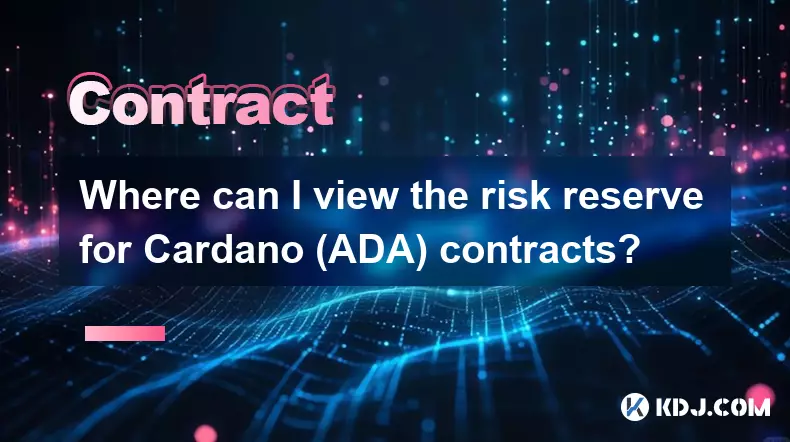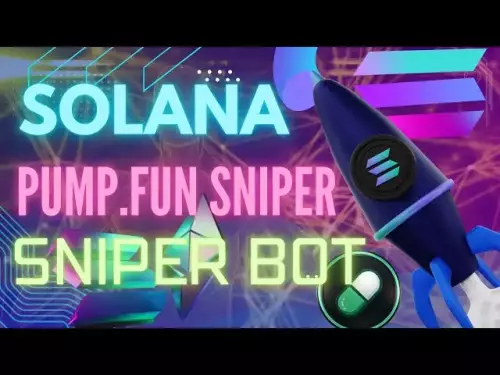-
 bitcoin
bitcoin $112195.049338 USD
2.42% -
 ethereum
ethereum $4124.915858 USD
2.81% -
 tether
tether $1.000570 USD
0.02% -
 xrp
xrp $2.861568 USD
2.25% -
 bnb
bnb $1000.346670 USD
3.04% -
 solana
solana $209.070819 USD
3.38% -
 usd-coin
usd-coin $0.999870 USD
0.02% -
 dogecoin
dogecoin $0.235379 USD
2.65% -
 tron
tron $0.335681 USD
-0.20% -
 cardano
cardano $0.803501 USD
3.38% -
 hyperliquid
hyperliquid $47.120881 USD
3.56% -
 chainlink
chainlink $21.501300 USD
3.44% -
 ethena-usde
ethena-usde $1.000571 USD
0.02% -
 avalanche
avalanche $29.793378 USD
3.62% -
 stellar
stellar $0.366964 USD
2.42%
Where can I view the risk reserve for Cardano (ADA) contracts?
Cardano's risk resilience is built on decentralization, treasury-funded governance, and community-led safeguards like multisig DAOs and audited Plutus scripts.
Sep 29, 2025 at 09:19 pm

Risk Reserve Overview in Cardano (ADA) Ecosystem
1. The concept of a risk reserve within the Cardano blockchain does not align with traditional centralized finance models where funds are set aside explicitly for contingencies. Instead, Cardano’s security and sustainability are maintained through its treasury system and decentralized governance framework. The Voltaire phase introduced project funding mechanisms that allow community-driven proposals to enhance network resilience.
2. Stake pool operators contribute to network stability by adhering to operational best practices and maintaining adequate uptime. While no single entity publishes a “risk reserve” balance for smart contracts, the decentralization level—measured by stake distribution across independent pools—acts as a structural safeguard against systemic failure.
3. Developers deploying Plutus scripts on Cardano are encouraged to conduct extensive testing using the pre-production networks like preview and preprod. These environments simulate mainnet conditions without financial exposure, enabling teams to identify vulnerabilities before launch.
4. Third-party auditing firms such as Redex Labs, AIS, and Concerto provide formal verification and penetration testing services for ADA-based contracts. Their public audit reports often include assessments of fund safety mechanisms and potential exploit vectors.
Transparency Tools for Contract Safety Monitoring
1. Blockchain explorers like Cardanoscan.io and Cexplorer.io allow users to inspect transaction histories, token holdings, and script addresses associated with dApps. By analyzing fund flows into and out of contract wallets, observers can infer capital management strategies.
2. The CIP-108 proposal outlines standards for decentralized project treasuries, which may evolve into recognized formats for disclosing reserve-like balances. Projects implementing this standard publish wallet addresses tied to community funds, visible via metadata on-chain.
3. Governance dashboards such as Adapools.org and PoolTool display real-time data about voting power distribution and proposal funding status. These platforms help track how much ADA is allocated toward development and emergency response initiatives.
4. Open-source repositories on GitHub linked to major dApp projects frequently contain documentation detailing fund allocation policies, including percentages set aside for insurance or recovery scenarios.
Community-Led Risk Mitigation Initiatives
1. Decentralized autonomous organizations (DAOs) built on Cardano often establish multisignature wallets requiring consensus among trusted members to release funds. These arrangements serve as functional equivalents to risk reserves, especially when backed by substantial ADA deposits.
2. Platforms like Jellyfish and Minswap DAO maintain liquidity pools funded partially by protocol revenue. Portions of these reserves can be redirected during extreme market events to stabilize trading pairs or compensate affected users.
3. Emergency response protocols are sometimes encoded directly into smart contracts, allowing predefined actions if certain triggers occur—such as automatic pausing of withdrawals after suspicious activity thresholds are met.
4. Community forums including Cardano Forum and Reddit’s r/Cardano host discussions around high-risk contracts, with experienced members highlighting red flags related to fund handling and transparency gaps.
Frequently Asked Questions
Where can I find audit reports for Cardano-based smart contracts?Audit reports are typically published on the official websites of development teams or shared through partnerships with auditing firms. Reputable projects link these documents directly from their landing pages or GitHub repositories.
How do I verify if a dApp has a dedicated treasury or reserve?Check whether the project discloses wallet addresses under governance control. Use blockchain explorers to monitor balances and transaction patterns. Look for references to CIP-108 compliance or DAO treasury structures in whitepapers.
Are there insurance options available for ADA smart contract losses?Yes, emerging decentralized insurance protocols like InsurAce now support coverage for select Cardano applications. Users must review policy terms carefully, as protection usually applies only to specific types of exploits and requires active participation in staking or bonding.
Can I track how much ADA is held in inactive contracts?Explorers like Cexplorer offer filters to identify dormant script addresses based on last activity timestamps. However, determining whether funds are intentionally locked versus abandoned requires additional context from project communications.
Disclaimer:info@kdj.com
The information provided is not trading advice. kdj.com does not assume any responsibility for any investments made based on the information provided in this article. Cryptocurrencies are highly volatile and it is highly recommended that you invest with caution after thorough research!
If you believe that the content used on this website infringes your copyright, please contact us immediately (info@kdj.com) and we will delete it promptly.
- Axl Rose's Graphic Novel: Can He Save Humanity From Paradise City?
- 2025-09-30 02:45:11
- Axl Rose's 'Appetite for Destruction' Gets a Graphic Novel Makeover!
- 2025-09-30 02:45:11
- Pi Network Founders' Dispute and Marriage Issues: A Deep Dive
- 2025-09-30 02:50:01
- Bitcoin Strategy Buys: Holdings Exceed Expectations in 2025!
- 2025-09-30 02:25:15
- Bitcoin's 'Uptober' Hope: Can It Reach $110K?
- 2025-09-30 02:50:01
- Mutuum Finance Presale Defies Market Volatility: A New Era for DeFi?
- 2025-09-30 00:45:13
Related knowledge

How do I use the scheduled order feature in Cardano (ADA) contracts?
Sep 28,2025 at 10:18pm
Understanding Scheduled Orders in Cardano Smart ContractsCardano operates on a proof-of-stakes consensus mechanism and uses the Plutus scripting langu...

Where can I view the risk reserve for Cardano (ADA) contracts?
Sep 29,2025 at 09:19pm
Risk Reserve Overview in Cardano (ADA) Ecosystem1. The concept of a risk reserve within the Cardano blockchain does not align with traditional central...

How do I enable the "scalping-only" mode for Cardano (ADA) contracts?
Sep 24,2025 at 03:19am
Understanding Scalping Strategies in Crypto Derivatives1. Scalping in cryptocurrency trading refers to executing multiple short-term trades within min...

What is the settlement time for Cardano (ADA) contracts?
Sep 28,2025 at 04:18am
Understanding Cardano's Contract Settlement Mechanism1. Cardano operates on a proof-of-stake consensus model known as Ouroboros, which fundamentally i...

How do I add margin to Cardano (ADA) contracts?
Sep 27,2025 at 07:54pm
Understanding Margin in Cardano (ADA) Smart ContractsCardano operates on a proof-of-stake blockchain that supports smart contracts through its Plutus ...

What is the maximum position limit for Cardano (ADA) contracts?
Sep 23,2025 at 11:00pm
Understanding ADA Futures and Derivatives Market Structure1. Cardano (ADA) futures contracts are offered by several major cryptocurrency derivatives e...

How do I use the scheduled order feature in Cardano (ADA) contracts?
Sep 28,2025 at 10:18pm
Understanding Scheduled Orders in Cardano Smart ContractsCardano operates on a proof-of-stakes consensus mechanism and uses the Plutus scripting langu...

Where can I view the risk reserve for Cardano (ADA) contracts?
Sep 29,2025 at 09:19pm
Risk Reserve Overview in Cardano (ADA) Ecosystem1. The concept of a risk reserve within the Cardano blockchain does not align with traditional central...

How do I enable the "scalping-only" mode for Cardano (ADA) contracts?
Sep 24,2025 at 03:19am
Understanding Scalping Strategies in Crypto Derivatives1. Scalping in cryptocurrency trading refers to executing multiple short-term trades within min...

What is the settlement time for Cardano (ADA) contracts?
Sep 28,2025 at 04:18am
Understanding Cardano's Contract Settlement Mechanism1. Cardano operates on a proof-of-stake consensus model known as Ouroboros, which fundamentally i...

How do I add margin to Cardano (ADA) contracts?
Sep 27,2025 at 07:54pm
Understanding Margin in Cardano (ADA) Smart ContractsCardano operates on a proof-of-stake blockchain that supports smart contracts through its Plutus ...

What is the maximum position limit for Cardano (ADA) contracts?
Sep 23,2025 at 11:00pm
Understanding ADA Futures and Derivatives Market Structure1. Cardano (ADA) futures contracts are offered by several major cryptocurrency derivatives e...
See all articles


























![[Pycoin] PI Coin -Shocking Listance of Pycoin?! 'Rebellion' This time ... Pay attention to #paikoin [Pycoin] PI Coin -Shocking Listance of Pycoin?! 'Rebellion' This time ... Pay attention to #paikoin](/uploads/2025/09/29/cryptocurrencies-news/videos/pycoin-pi-coin-shocking-listance-pycoin-rebellion-time-pay-attention-paikoin/68da82f23cec1_image_500_375.webp)















































